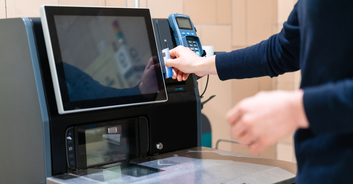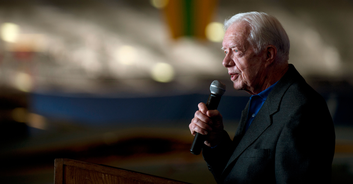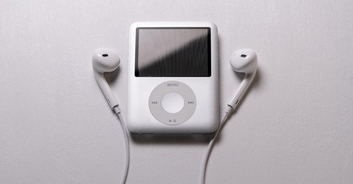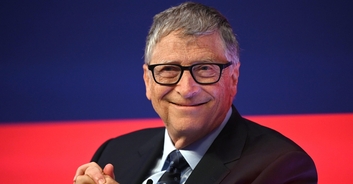In late 2004, the Purple Dorm was at full capacity. Nestled inside a building at Apple’s headquarters in Cupertino, California, this was the secret location of Project Purple and, unbeknownst to anyone, the war room for the battle of the century: Samsung vs Apple.
Staff wouldn’t leave for days at a time and the room would always smell of pizza, hence “dorm”. Outside, a piece of paper signposted it as “Fight Club”. (The first rule of Fight Club, according the the 1999 film, is not to talk about Fight Club”.)
The project was kept so clandestine that engineers and developers were roped in before they understood what they would be doing. One of the first prototypes, codenamed the M68, had “iPod” stamped on it in order to disguise what it was. It was top-secret.
Finally, in January 2007, at the Macworld trade conference, in San Francisco, Apple’s then-CEO Steve Jobs made an announcement. “We’re going to make some history together today!” he said to a huge crowd.
“This is a day I’ve been looking forward to for two and a half years.” There were a couple of claps and a cheer but the majority of the nerds, designers and Apple-fanatics waited with bated breath.
“Every once in a while, a revolutionary product comes along that changes everything,” Jobs said. “Today, we’re introducing three revolutionary products of this class.” The first was an iPod with a touch screen, the second was mobile phone and the third was a groundbreaking internet communications device. “An iPod, a phone, and an Internet communicator. An iPod, a phone …” he enthused. “Are you getting it? These are not three separate devices. This is one device! And we are calling it iPhone.”
The crowd cheered and on a screen behind Jobs appeared the word “iPhone” along with the caption “Apple reinvents the phone”. It was a bold claim but, with a small oblong of circuitry, they had changed consumer electronics forever. Apple had put the development of a tablet on hold in order to focus on their phone and, eventually, the gamble paid off. While the first version didn’t hit its sales targets, with the iPhone 3G, Apple found a winning formula.
Its fourth major purpose, which Jobs failed to mention, was a status symbol. This helped the phone sell in its millions and by 2009, Apple had 16 per cent of the total market share for global smartphone sales. Meanwhile, a report by industry research firm IDC put Samsung’s share under the category “Other”.
Samsung were excellent at creating phones. But smartphones was a whole different ball game and, unfortunately for them, this seemed to be where the market was going. However, Samsung had a trick up its sleeve which it had been using for a while.
The Korean company employs a controversial suit-countersuit tactic when it comes to intellectual property. As an electronics giant, it fully accepts that others will steal its technology but doesn’t pursue legal action. That is, until someone pursues legal action against them. With so many parts and patents, they can be sure that there will be some degree of legally-murky overlap.
However, Samsung also willfully uses others’ technology. “They never met a patent they didn’t think they might like to use, no matter who it belongs to,” explains Sam Baxter, a patent lawyer. “I represented Ericsson, and they couldn’t lie if their lives depended on it, and I represented Samsung and they couldn’t tell the truth if their lives depended on it.”
Samsung would typically wait until a product was about to be barred from a particular country, or until it looked like they were about to receive a fine, and then suddenly stop using the technology and settle out of court. However, their methods went further than just thieving ideas.
They successfully inflated prices by colluding with competitors, an early example of which was related to cathode-ray tubes (CRTs). From 1996 to 2006 they they would hold “Glass Meetings” at hotels and resorts around the world, or “Green Meetings” on some of the world’s best golf courses, where they would agree to raise prices and cut production - in order to boost profits.
When LCD screens began to take hold of the electronics market, Samsung conspired with competitors in “Crystal Meetings”. However, there were soon rumours that a company known only as “NYer” was going to shop them to the authorities. We now now that NYer was in fact Apple.
When they were caught in 2005, Samsung agreed to pay $300 million in fines to the US government and six of its executives agreed to serve sentences of up to 14 months in American prisons. Then between 2011 and 2012, Samsung was fined additional sums - $32 million in the US, $21.5 million in South Korea and $197 million by the European Commission - relating to the Glass Meetings.
A case against Samsung by Sharp eventually reached The Hague, where it was deemed that Samsung had illegally copied their LCD technology. However, legal proceedings are both costly and time-consuming. Sharp filed the lawsuit in 2007 and by 2009, when the case came to a close, Samsung held 24 per cent of the global market in televisions, while Sharp had only 5 per cent.
However, this was all in addition to other accusations and legal issues. By paying off prosecutors, Samsung could avoid having to pay fines. Until, in 2007, Samsung’s former top legal officer, Kim Yong-chul outed the company, claiming that they were crooks. Senior executives stood accused of evidence tampering, money-laundering, the bribery of both civil and governmental individuals and stealing as much as $9 billion. Others produced evidence which seemed to back up this claim. A former presidential aide said they had tried to give him a cash gift of $5,400 while a Korean legislator claims she was offered a gold bag full of cash.
Both the office and home of Lee Kun-hee, the former chairman of Samsung, were raided. He was subsequently convicted of evading $37 million in taxes. Given a three-year suspended sentence, he was ordered to pay $89 million in fines.
Clearly, Samsung had previous. It has, of course, attempted to change its image. “Samsung has made tremendous advancements in addressing compliance issues,” says Jaehwan Chi, executive vice president of global legal affairs and compliance. “We now have a strong corporate compliance organization, with a dedicated staff of lawyers, a set of clear policies and procedures, companywide training and reporting systems. As a result, every single one of our employees today, whether they’re in the Americas, Asia, or Africa, are given compliance education on an annual basis.”
However, in seeing Apple’s success and their comparative failure, Samsung bosses set about ascertaining why the iPhone was so much better than anything they could produce. On an otherwise-banal Wednesday morning in February 2010, around 30 Samsung executives met in the Gold Conference Room at the company’s headquarters in Seoul.
It wasn’t called a “crisis meeting” but there was certainly a crisis. “[Our] quality isn’t good,” the memo quotes the head of the division as saying, “perhaps because the designers are chased along by our schedule as they get so many models done.” A purveyor of choice, they simply had to stop producing so many phones.
“When our [user experience] is compared to the unexpected competitor Apple’s iPhone, the difference is truly that of Heaven and Earth.” In agreement that changes had to be made, the case was handed over to the product engineering team, who created a report which detailed all 126 instances where the iPhone, in whatever small way, was triumphant.
Bit by bit, all the minor differences added to a growing list of key takeaways which formed the basis of Samsung's new approach. Over the next few months, Samsung worked away at creating their own winning formula.
On March 23, at the CTIA Wireless trade show, Samsung made their own announcement. “Of course, by now, you are probably thinking I must have a new device to show you that delivers all these new experiences,” stated JK Shin, the head of Samsung’s mobile-communications unit. “And I do,” he added, producing a phone from his pocket and stated: “Ladies and gentlemen, I present to you the Samsung Galaxy S!” This was the beginning of the war. Samsung vs Apple.
From the handset to the icons to the way the user interacted with the software, it was strikingly similar to the iPhone. In fact, Google executives had already stated that it bore many similarities to it. An email was sent, within Samsung, stating: “Since it is too similar to Apple, make it noticeably different, starting with the front side.”
However, it was nowhere near different enough for Steve Jobs to be happy. That said, Apple was also busy pushing the newly-released iPad and Jobs’ then-Chief Operating Executive was keen to speak to Samsung rather than fight them in court. After all, many of Apple’s parts were purchased from Samsung.
In August 2010, executives from Apple met with Samsung’s lawyers and engineers in Seoul. Even down to the pinch-to-zoom function and the “rubber banding” where the image bounces to let the user know they’ve reached the bottom of the page, Apple were certain that Samsung had taken the iPhone's features and put them into the Galaxy S. Far from being functionally useful, the meeting got nowhere. However, court documents have immortalised the awkward conversations which took place.
Chip Lutton, then Apple’s associate general counsel for intellectual property, had come prepared with a presentation entitled “Samsung’s Use of Apple Patents in Smartphones”.
“Galaxy copied the iPhone,” he professed.
“What do you mean, 'copied'?” Dr. Seungho Ahn, a Samsung vice president replied.
“Exactly what I said,” Lutton stated. “You copied the iPhone. The similarities are completely beyond the possibility of coincidence.”
“How dare you say that,” Ahn replied. “How dare you accuse us of that,” he insisted, before adding: “We’ve been building cell phones forever. We have our own patents, and Apple is probably violating some of those.”
After the meeting, Apple’s Chip Lutton asked for a response to their concerns. “Steve Jobs wants to hear back and wants to hear back quickly,” he said. “And please don’t give us a general thing on patents.”
At a later meeting in Washington DC, Apple’s lawyers suggested that Samsung stop using any Apple technology that made the iPhone distinctive and pay royalties for using any Apple technology which didn’t play a role in making the iPhone distinctive.
In March 2011, Samsung announced the release of their tablet. Yet again, Apple considered this to be nearly identical to one of their products: the newly-released iPad 2. In April, Apple finally filed lawsuits for infringing on the patents of both the iPhone and the iPad. Suits were filed in the US, Britain, France, Italy, Spain, the Netherlands and Australia.
However, Samsung was already in trouble. The previous month, there had been a raid on a Samsung facility in Suwong. The raid was related to an investigation into collusion with phone networks to fix prices. Crucially, security guards didn’t let the investigators into the building and the police had to be called.
In the time it took to get the police to the scene, show them the paperwork and have access approved, employees inside were industriously destroying evidence and switching computers. This could all be seen on the CCTV footage which was seized by the investigators.
Having already questioned Samsung engineers over patents, Apple were in a strong position when they entered the courtroom. After all, many of the individuals they had questioned couldn’t explain the technology which had their name on the patent.
The courtroom battle between the two tech giants was intense. At one point, federal judge Lucy Koh held up the iPad and Galaxy Tab 10.1 and asked Samsung lawyer Kathleen Sullivan if she could tell the difference.
“Not at this distance, your honour,” she replied, despite standing only around 10 feet away.
Various courts made decisions which either sided with Apple or with Samsung. In Tokyo, for instance, a court rejected Apple’s claims and ordered they pay Samsung’s legal fees. A California jury found that Samsung had violated patents for both the iPhone and iPad, awarding more than a billion dollars in damages (an amount that was later recalculated, meaning Samsung paid closer to half a billion dollars).
In the great Samsung vs Apple duel, it seemed that Apple was the victor. Furthermore, despite various misinformed reports, Samsung did not pay Apple in truckloads of nickels (this was just a strange urban legend).
Nonetheless, the Purple Dorm, the evidence tampering, the stolen technology, the bribery and the price fixing all seemed to be real. Clearly, in the world of consumer electronics, there are many geeks and techies but there are also some fairly shady goings on.












